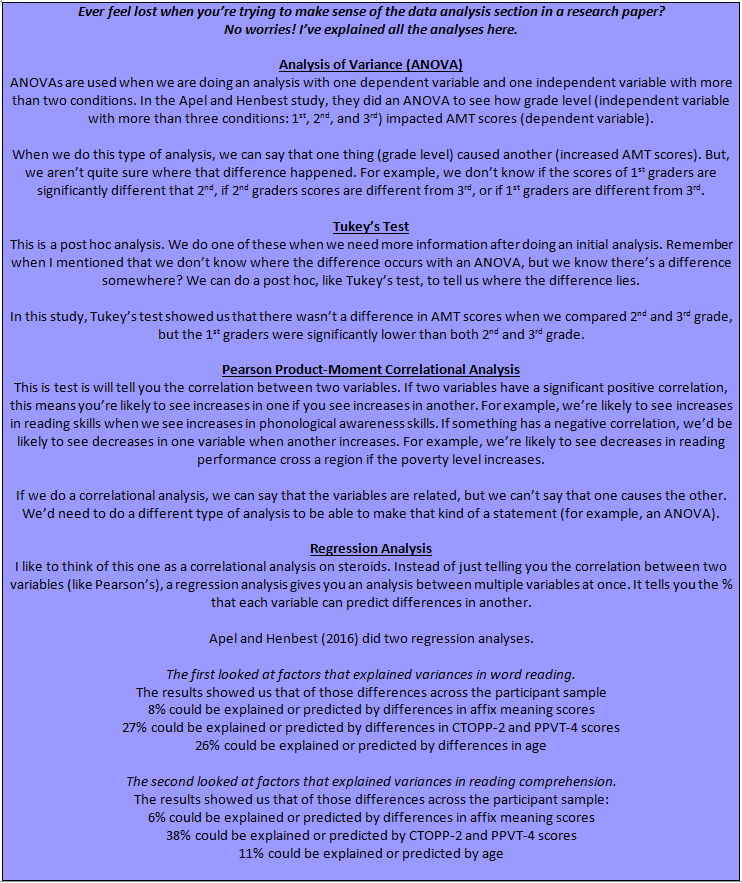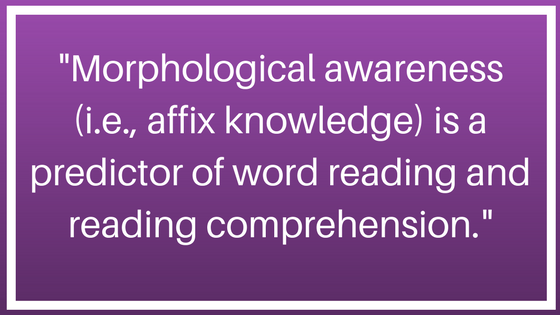Have you thought about morphological awareness lately?
If you have students with weak vocabulary, grammar, and spelling skills, it might be time to start.
It can be hard to figure out how soon we should start teaching students about morphology and building their morphological awareness skills.
In this article, I’m going to summarize a study in this article that can help to answer this question.
Before we start, let’s revisit a question I brought up in my most recent article, Grammar and Spelling Intervention: The Missing Piece. I’m talking about it again, because I hear this question asked A LOT by other SLPs and other professionals working in the schools.
This great question came from a member of my course, Language Therapy Advance in the member’s only Facebook community:
My third grade student has good phonological awareness skills, but can’t spell. What should I do?
This post prompted another question from another one of my members who asked, “Have you thought about morphology?”
She was right on the money.
We’ve established that phonological awareness both impact and predicts reading performance (Hogan, Catts, & Little, 2005; Torgesen, Wagner, and Rashotte, 1994), but there’s more to the story.
Some kids need more than work on phonological awareness, and SLPs need to know what that is.
In many recent discussions on various online forums for literacy specialist and SLPs, the topic of morphology and morphological awareness has come up quite a bit. No one seems to doubt that it’s important and that we should be working on it.
The question that seems to cause some debate is how soon we should do it.
I’ve heard questions like:
“What if my students can’t read/are poor readers?” “Can I work on morphological awareness?” “Are they ready?”
If weak morphological awareness is contributing to their reading and spelling difficulties, the answer is, “Yes”.
We don’t want is to come too little too late because we think our students can’t handle it, which is why we need some answers.
That’s why I’m going to describe the study done by Kenn Apel and Victoria Henbest (2016). Here’s the entire reference:
Research Questions
Here’s what the Apel and Henbest (2016) wanted to know:
Question 1: Are there significant differences in the morphological awareness skills across 1st, 2nd, and 3rd graders?
They defined morphological awareness as affix meaning knowledge. Affixes include both prefixes (bound morphemes found at the beginning of words) and suffixes (bound morphemes found at the end of words).
Why did Apel and Henbest ask this question?
If I were to guess, I’d say it’s because they wanted to get a better picture of the developmental hierarchy across the early grade levels. This way, we have a better picture as to when we should start working on morphological awareness.
 Question 2: Can morphological awareness (measured by affix knowledge) explain and predict differences in reading, phonological awareness, and vocabulary?
Question 2: Can morphological awareness (measured by affix knowledge) explain and predict differences in reading, phonological awareness, and vocabulary?
The authors wanted to see if there is a relationship between morphological awareness and other skills (i.e., phonological awareness, reading, and vocabulary) correlated with academic success.
Knowing this could pinpoint the kids who need intensive explicit instruction focused on morphology and morphological awareness in the early grades.
Participants
Participants for the study were 1st, 2nd, and 3rd graders (40 per grade level) in the US ranging from 6:11 through 9:1.
Methods and Measures
The authors administered a number of different evaluation tools and then analyzed the results to answer the two research questions.
The measurement tools were:
The Affix Meaning Task (AMT) to measure affix knowledge and morphological problem solving.
The Test of Word Reading Efficiency-2nd Edition (TOWRE-2) and the Test of Silent Reading Efficiency and Comprehension (TOSREC) to measure reading skills.
The Comprehensive Test of Phonological Processing to measure phonological awareness
The Peabody Picture Vocabulary Test-4th Edition to measure vocabulary.
The TOWRE-2, the TOSTREC, The CTOPP, and the PPVT-4 are all norm-referenced evaluation tools, so those are pretty straightforward, but I’m going elaborate here on the tasks in the AMT because it was created by Apel and Henbest for the study.
When completing the AMT, the students saw a pseudoword, and then saw the word with a number of different affixes attached to it.
Then the researchers gave them a definition, and asked what word went with the definition.
For example, one of the pseudowords was “glack”. The students saw words such as “reglack”, or “glackable”, and had to pick which word went with the definition, “to glack again.”
Before I go any further, I imagine you might be wondering why on earth we’d want to test our students’ ability to infer meanings of words that don’t exist.
That’s a fair question, and it comes up a lot with these kinds of tasks.
The reason nonsense words were used is because the purpose of the task was to assess morphological problem solving.
In order for the researchers to assess whether or not the students could infer meanings of unfamiliar words, they had to ensure that there was no possible way the students knew the meanings through prior exposure.
The only way to do that is to use an assessment with words that aren’t real words. Remember the examiners were assessing the problem solving process, not content knowledge alone.
Where the authors were assessing content knowledge was with their use of affixes. You’ll notice that the affixes in the example above (“re”, “able”) are true affixes.
By pairing them with nonsense words, the researchers were able to ensure that students answered questions correctly because of their affix knowledge, not their knowledge of the base word.
Results
Let’s go back to the first research question:
Were there differences in affix knowledge across grade levels?
Yes, there were in this participant sample.
How do we know?
Well first, our ANOVA told us that there was a significant main effect for grade level. That means that across grades 1, 2, and 3, there were significant differences…but we’re not quite sure where. We’re still wondering if 1st graders different from 2nd graders? Were 2nd graders different from 3rd graders?
To answer this question, the authors did a post hoc analysis, which in this case was the Tukey’s test. Tukey’s test shows us where the differences were. What it showed was this:
The affix knowledge of first graders was significantly lower than 2nd and 3rd graders.
There was no significant difference between 2nd and 3rd grade.
These results could mean that a big boost in affix knowledge happens after 1st grade.

Now let’s move on to the next research question.
Can affix knowledge (or morphological awareness) explain variances in vocabulary, reading, and phonological awareness?
The quick and dirty answer is, “Yes”.
But of course, we need to look at the numbers.
Apel and Henbest (2016) did a Pearson-product moment correlational analysis. This analysis showed a significant correlation between affix knowledge and all the other skills mentioned.
This means that if a student has strong morphological awareness skills, they are likely to have strong phonological awareness, vocabulary, and reading skills.
Last, but not least, we need to talk about the regression analysis.
The regression analysis showed that 8% of the variance in word reading could be explained by affix knowledge, and 6% of the variance in reading comprehension could be explained by affix meaning knowledge.
Both of these results were considered to be a significant amount, which means that morphological awareness (i.e., affix knowledge) is a predictor of word reading and reading comprehension.
If some of these data analyses seem confusing, take a look at this cheat sheet below that explains each analysis Apel and Henbest (2016) did.

Conclusions
If you’re working with the school-aged populations and you aren’t thinking about morphology…you should start now.
Why? Because students with weak morphological awareness skills are likely to struggle with reading.
And it’s actually fairly easy to work this in to your therapy if you have a solid system in place, which is what my Language Therapy Advance students find.
We know now from the results of this study (Apel & Henbest, 2016) that students are capable of learning affixes and using them to build their vocabulary as early as first grade.
This is consistent with other studies that suggest that children are not only capable of learning these skills early on, but that morphological awareness has a positive impact on reading performance (Apel & Lawrence, 2011; Apel, Brimo, Diehm, & Apel, 2013; Bowers, Kirby, & Deacon, 2010).

Now, for the next logical question:
Now that we know morphology and morphological awareness are important, what do we do about it?
The quick and dirty answer is that we need to starting working on morphological knowledge directly. I share how to do that in the Word Study Toolkit for SLPs.
This is a huge problem-especially for students on your caseload who are struggling with language!
As you already know, some students can’t do this!
Students aren’t able to fluently and accurately decode complex words…
They missed out on years of valuable vocabulary exposure in elementary school…
Comprehension suffers…and so does writing quality.
And worst of all, students start to hate school and think less of themselves.
I know you don’t want that for your students.
Things like this used to keep me up at night.
I know how heart wrenching it can be to see your students struggling to read and spell, but feeling unsure of how to help.
I also know how nerve-wracking it can be to get a new referral, but not have the answers about how to intervene.
I’ve felt the frustration of feeling like more of a spelling tutor than a “language expert.”
But the good news is that it doesn’t have to be this way.
But I know you don’t have time to go digging for lists of prefixes, suffixes, roots/bases, and multiple meaning words.
So I’ve done the grunt-work for you and put them in to the toolkit just for you.
Here’s what’s inside the Word Study Toolkit:
✅Over 200 flashcards with prefixes, root/base words, suffixes, and multiple meaning words to build strong reading and spelling skills.
✅Word lists with key orthographic concepts, so you have a quick guide to important word parts needed for strong vocabulary skills.
✅Descriptions of 17 key concepts for building morphology/orthography skills
✅All flashcards and word lists have definitions, so your students actually remember how words are spelled.
✅BONUS: Video tutorials with a quick-guide for using the toolkit to build reading and spelling skills.
>>>Take a peek at what’s inside the toolkit here.
References
Elleseff, T. (2015). Have you worked on morphological awareness lately? Retrieved July 17, 2017 from https://www.smartspeechtherapy.com/have-you-worked-on-morphological-awareness-lately/


